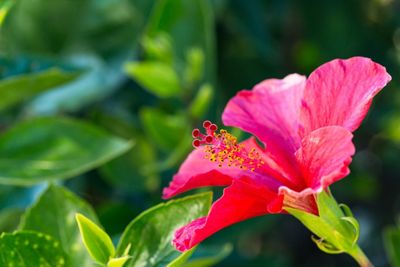Hibiscus Growing in Zone 9
Few plants can match the beauty of hibiscus plants. In zone 9, you have the option of choosing a tropical variety grown in a pot and overwintered indoors, or a hardy species which can be grown in ground. The hardy varieties can withstand temperatures of -30 degrees F. (-34 C). Hibiscus that grows in zone 9 are unlikely to experience such low temperatures but it is good to know they have the ability to survive cold weather. No matter what type of hibiscus you choose, they require full sun and well-draining soil. Hibiscus need five to six hours of bright light. However, exposure to the hottest heat of the day can sunburn the plant, so plan to plant in a location with morning or afternoon sun. Indoor plants can be set in the southern or western part of the home, but away from the window. Zone 9 hibiscus should be kept evenly wet but not boggy. Allow the soil to dry out to the touch before successive watering. Hibiscus will produce copious blooms if fertilized. Use a complete diluted or time release formula. A ratio of 10:4:12 or 12:4:18 is appropriate for hibiscus growing in zone 9.
Hardy Hibiscus That Grow in Zone 9
Rose mallow is a hardy hibiscus that will thrive in zone 9. The common form has white blooms but there are numerous cultivars from which to choose. You can choose from plants that give ruffled pink blooms, lavender flowers, several red forms, and even a pink and white blooming plant. Confederate rose is another hardy specimen. It has the capacity to grow 15 feet tall (5 m.) and bears pink to white blooms that deepen in color by day’s end. Texas star is an outstanding plant with deeply red blooms. It requires moist soil and has lobed leaves. Rose of Sharon is a classic, old-fashioned hibiscus. It blooms from summer until the first frost when it drops its leaves. There are cultivars with single or double flowers. Each of the hardy species has several other forms that can enhance your sense of color and provide you with the size plant you wish.
Tender Hibiscus Plants for Zone 9
If you have your heart set on a tropical variety, you can use these outdoors from spring until the end of summer. At that time, you will need to bring the plant indoors to save it. Hibiscus rosa-sinensis is the commonly known tropical species. Others are Hibiscus acetosella and Hibiscus trionum. Each has single flowering or double bloom forms. You can choose from yellow, red, orange, pink, white, and more. These plants must be kept moist. Container grown plants should be watered when the top of the soil is dry to the touch. Leach the soil every month by repeatedly adding water so excess salts can flow out of soil. Place indoor plants at the sunniest window of the home. Outdoor plants can tolerate partial shade.
